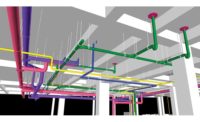Software for the MEP segment continues to rapidly evolve, allowing engineers to improve accuracy and optimize building system design by enhancing collaboration and sharing data between all members of a project, which in turn, helps speed project completion.
Top trends
According to Chris Peppler, senior director of marketing and product management, Trimble, the top three trends in software are the Cloud, collaboration and a move toward structured and unstructured data.
“The No. 1 thing that absolutely has emerged for us is the Cloud,” he says. “I was a little surprised at some of the resistance in the industry to the Cloud, but obviously, it goes without saying that the situation with COVID-19 has created an urgency. Anybody who thought they were never going to move to the Cloud, or that the Cloud didn't have the benefits that they needed, has probably learned that lesson pretty quickly. Many of our products that are Cloud-based have seen a significant uptick in demand as a result —almost immediately, actually.”
Collaboration and data sharing are also on the rise, Peppler notes.
“I think there's actually a willingness and a change within the industry to collaborate on a deeper level,” he adds. “And you can't do those things with what I would call ‘construction software 1.0,’ right? I think a large portion of the industry is still operating under software that we've all been using since the 80s, 90s and early 2000s — software that locks information on somebody's desktop, in somebody's personal file structure, or maybe inside a company, which makes it really hard to share that information.
“We’ve been talking to an engineering firm that is very interested in changing the way engineers and contractors work together, because they see the problems,” he continues. “Such as engineers are unwilling to share, or engineers originate a particular workflow and they don't know how problematic it is when it comes to implementation by a contractor. There's a real willingness in the industry to start collaborating on a much deeper level, and that's forcing the use of the Cloud — you can't do these things without more collaboration tools.”
Will Gunter, Technical Solutions Executive, Autodesk Construction Solutions, agrees collaboration is an increasing factor when it comes to software.
“We’re seeing engineering and design firms use software for early model coordination to ensure there aren’t any clashes between building systems,” he explains. “For example, designers and subcontractors can get coordinated early in the project lifecycle to ensure mechanical and plumbing systems don’t run in to each other, concrete beams don’t interfere with electrical systems, and so on.
“Additionally, organizations are increasingly adopting technology integrations to address collaboration and productivity challenges across workflows,” Gunter continues. “The industry is looking to connect individual software solutions adopted for particular workflows, so information can be shared easily across various construction project team members without manual data entry.“
Prefabrication is another growing trend, Gunter notes, as it allows designers and contractors to save project time and minimize footprints onsite.
“Teams are manufacturing systems offsite and assembling them onsite — this approach requires a lot of communication between people in different phases of the project lifecycle and in different physical locations,” he says. “Organizations in the industry are turning to cloud collaboration solutions for work such as model coordination, quantity takeoffs, QA/QC, RFIs and more.”
As with most industries, there is a growing need to do more with less, Gunter explains, and that is driving these current software trends.
“The industry needs to save time and money. Technology that enables instant communication and collaboration is a key part of the solution,” he adds. “And, with the impact of the current COVID-19 pandemic, there has been an increase in the number of employees working from home which has accelerated the trend towards coordination software between design disciplines.”
Key benefits
According to a SmartMarket Report from Dodge Data & Analytics, there are two types of benefits of using BIM in mechanical construction: Those that are project-related and those that directly impact the BIM user’s company. Project-related benefits include better collaboration between stakeholders; greater understanding of design intent; improved cost performance; improved fabrication process; improved quality of work; improved schedule performance; and reduced errors and waste. Company related benefits include attracting and retaining talent; better utilization of resources; enhanced industry reputation; improved safety performance; increased labor productivity; increased profitability; maintaining repeat business; and winning new work.
Woody Dickinson, marketing technical manager, Caleffi North America, says there is a growing need for BIM models in designing plumbing and hydronics system projects.
“Many engineering firms subscribe to third-party spec writing services — such as MasterSpec — where manufacturers pay to be included as basis of design, or some manufacturers offer spec writing services and software that create the engineering spec around their product. Additionally, there are other online tools that include searching for manufacturers, downloading PDFs, etc., requesting quotes and more. These provide workflows from office to field, beyond BIM to fabrication and fieldwork with construction data. These types of software improve quality of design, provide higher client satisfaction in proper building functioning, longer operating lifecycle and system and component histories for downstream operation and maintenance.”
Ralph Schoch, Revit, technology and internal support manager at Victaulic, says Revit tools help save time and money on projects.
“The buildings that we're building today are not the ones we used to build 10 years ago — they're much more complicated,” Schoch says. “There is a push for square footage, so every square foot in that building is more and more valuable because of the shortage of space in a lot of cities. Being part of the mechanical piping and MEP side, we're seeing our systems compressed and packed into tighter unusable space by the owners and stakeholders of the building. We always get the worst space in the building to try to fit our systems in, and it's always a challenge.
“All these different BIM tools really come down to a planning tool,” he continues. “They allow you to plan and manage your construction, manage your risk and make sure what you're planning is going to fit. We see more and more prefabrication on the MEP side, and as we do that, we're taking on more risk. If that prefabrication doesn't fit in the building, all the benefits we would have gained by prefabricating are lost. It’s just that much more critical.”
The pros and cons
Peppler says the definite pro of using collaborative, Cloud-based tools is data redundancy because engineering firms will have a data backup should they experience computer failure or some type of disaster. As for cons, he points to adoption.
“It’s a struggle in the industry right now to make the shift to 3D modeling software,” he says. “If you really want to receive the benefits of BIM or constructability, you’ve got to adopt new technologies and new ways of working to add more detail to your model than you ever did before. There’s a huge perceived barrier to entry to adopt these things.
“It’s human nature to resist change,” he continues. “People get comfortable with what they know and the way they’ve always done things. Additionally, many of the tools are very technical, and it’s a shift to actually draw in 3D and to think about projects that way. For example, if I’m thinking about an 8-inch pipe for a space, in the past, I might have just drawn it as a line on a piece of paper or a line in 2D on a piece of software. But to actually think about this 3D model and drawing it from scratch in 3D, it’s a paradigm shift.”
As such, Trimble offers different levels of training with its MEP products, such as SysQue. Peppler says there has been a large shift toward virtual training, so the company has invested in virtual instructor-led trainings which are highly sophisticated classroom environments.
Gunter agrees there can be a learning curve in terms of implementation of new software.
“Everyone has different aptitudes for adoption, especially with new technology,” he says. “But once teams are able to overcome barriers to adoption, they can quickly begin to see the benefits.”
Schoch notes that the COVID-19 pandemic has actually pushed companies to adopt new software and train their employees on it.
“Teams having to work remotely is something that is a reality with COVID-19,” he says. “Having the ability to go remote and not miss a beat because all of your data and information is available is a huge advantage. I’m also seeing a lot of companies take this opportunity in between project delays and shut downs to really sharpen the saw and get training in for their teams. We've actually seen quite a few companies in the last few months that have made the jump over from their old AutoCAD workflows to Revit workflows. They've started using our software and tools to build and manage their fabrication from the shop out to the field.”
Victaulic boasts a 115-person BIM team which works on roughly 2,000 projects globally each year. Schoch says Revit allows the team to develop a lot of different tools on top of the platform, which helps avoid mistakes.
“When using the software and building technologies, it makes that team more efficient. We’re not just a manufacturer, but for VDC projects, we partner with customers and do all the design work, layout and even prefabricate for their mechanical rooms. It’s a service we can provide to all our customers, and if we have a customer that’s interested in Revit and seeing what using Victaulic Tools for Revit could actually design and fabricate, we’re more than happy to work with them on the process and teach them how to use the toolbar themselves.”
Dickinson notes that Caleffi keeps up-to-date BIM files on various software platforms as well as on its own company website.
“Our models are up to date and we keep them current for product models currently catalogued,” he says. “We create and manage our BIM content directly, all the products are modeled starting from scratch in Revit. We do have a number in construction to cover new products and changing products, so the process is always ongoing.”
Peppler says Trimble’s library of content allows users to access millions of components specific to the manufacturer.
“We have hundreds of people globally that create, manage and make sure all that content is accurate,” he says. “And we're moving more and more toward pairing all that managed content with our applications.
Autodesk construction solutions also tie into design products such as Revit, which are widely adopted across the industry, Gunter notes. Connecting design and construction in a common data environment makes information and project management easier for teams and can help drive greater productivity.
“After being in the AEC industry myself for many years, I decided to shift to the technology side because I saw its value firsthand,” he says. “Every day, our customers can use our products to stay on the pulse of the industry’s latest trends. In today’s industry, software plays an important role in helping companies build quality infrastructure and deliver results for clients. And as software itself develops further to support more advanced construction workflows, we’ll likely see more gains in productivity across the industry.”
Trimble Connect, which pairs with SysQue, is a collaboration platform that allows people to share data and models in the Cloud.
Autodesk’s BIM 360 features a Clash Matrix which allows users to view clashes across all published models in a coordination space and drill into clashing objects. Heat maps identify models with the most clashes to prioritize coordination efforts.
Caleffi keeps up-to-date BIM files on various software platforms as well as on its own company website.
Victaulic Tools for Revit Systemizer tool allows users to quickly define piping systems, and showcases how to apply optimal parameter values based on piping systems in their Revit projects.







